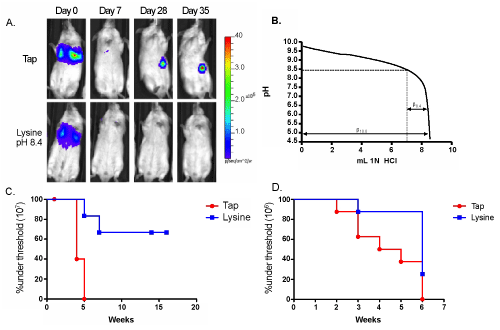
 |
| Figure 3: Lysine free base reduces metastases through pH buffering. SCID mice were divided in two groups: the “control” group and a “lysine” group, which received supplementation of lysine free base in drinking water at pH 8.4. Both groups were injected with the bioluminescent PC-3M prostate cancer cell line (A). In order to determine if the metastatic inhibition was due to the pH buffering properties of lysine, or due to its metabolism, we titrated lysine down to a pH of 8.4, using HCl (1N), a pH at which the pH buffering capacity is significantly reduced (β10.0=8.5 mEq vs. β8.4=1.5 mEq). (B) Tumor burden was quantified through in vivo bioluminescence along 6 weeks, and the effect of “de-buffered” lysine in survival was compared with the previously published results of lysine at pH 10 [15]. The lethal burden threshold for the survival curves was set at 3-fold the background signal (Rose criterion), which was considered as being the bioluminescent signal one week post injection. According to the Log-rank (Mantel-Cox) test, there was a significant increase in overall survival in the group orally supplemented with lysine pH 10 (P=0.0038, median survival control=4 weeks, median survival lysine pH10.0=undefined) (C). In this work, mice in the group supplemented with “de-buffered” lysine (pH8.4) showed a less noticeable difference in survival compared to the control group (P=0.0417, median survival for control group=4.5 weeks, median survival for lysine pH8.4=6), which reinforces the idea that the anti-metastatic properties of lysine are linked to its pH buffering capacities, rather than its metabolic properties (D). |